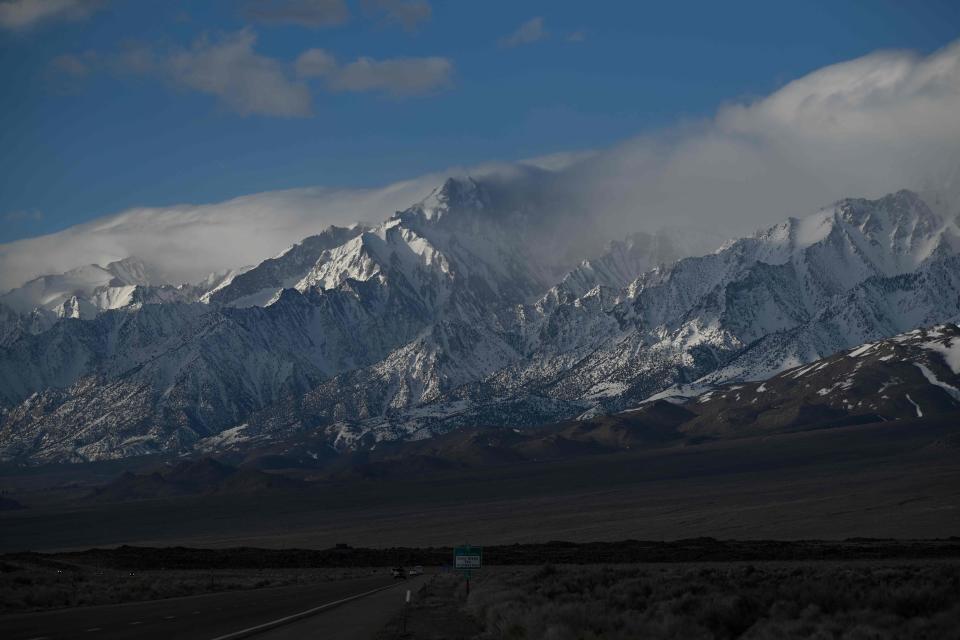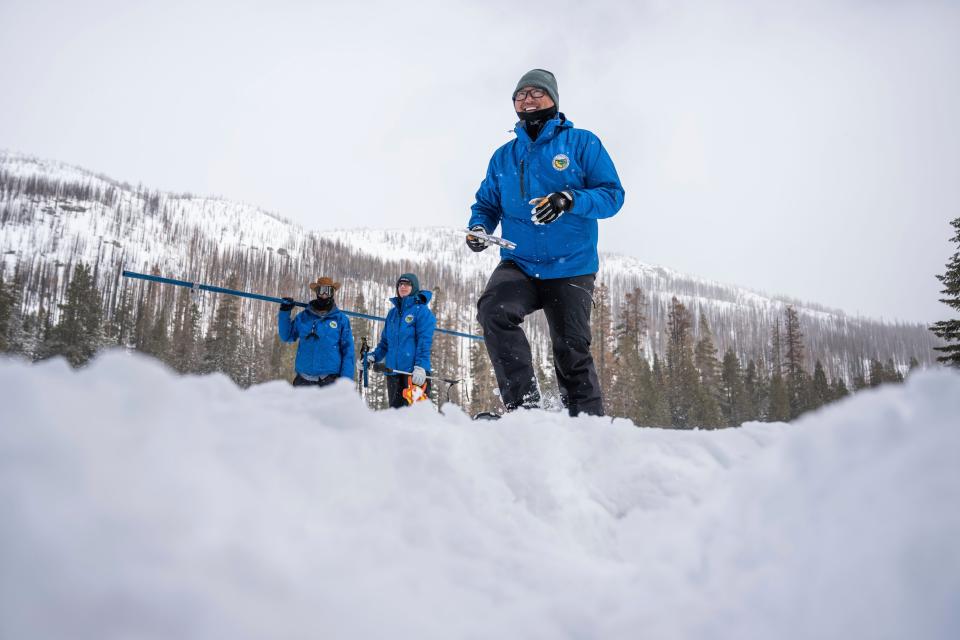Huge snowpack brings flooding fears to California, the West. Here's what to know.
The phenomenal, record-smashing snowfalls that buried mountainous swaths of the western U.S. this winter have left behind a huge snowpack.
That's a blessing for a region plagued by drought. It's also a potential disaster if it melts all at once.
The spring melt has already begun. In recent days, some disruptive floods have occured in the Rockies, but some of the biggest concern for snowmelt flooding is in California, which has yet to see much in the way of extreme warmth this spring.
An above normal to record snowpack in the Sierra Nevada, combined with elevated soil moisture, increases the threat of spring flooding due to snowmelt, especially at high elevations, the National Oceanic and Atmospheric Administration said.
PREVIOUSLY: Trillions of gallons have soaked California. Is this the state's wettest winter ever?
GRAPHICS: See how drenched California is — and why it would take multiple years like this to erase drought
"Approximately 44% of the U.S. is at risk for flooding this spring,” said Ed Clark, director of NOAA’s National Water Center. “California’s historic snowpack, coupled with spring rain, is heightening the potential for spring floods.”

How much snow?
Federal mapping shows large areas of California, Utah and Nevada have snowpack that's more than twice as deep as normal. Some automated monitoring sites even show snowpack that's seven or 10 times deeper than usual.
Looking at snowpack across the West, record-breaking conditions were reported in the Sierra Nevada, Great Basin, ranges of the Colorado Plateau in Utah and northern Arizona, and in the central and southern Rockies of western Colorado, northern Utah, and southeastern Idaho, according to the most recent U.S. Drought Monitor of April 13.
FROM JANUARY: 30 feet of snow? That much has fallen in some places in California as snow blankets huge swaths of state.
PHOTOS: Before and after photos show California reservoirs replenished after historic rains
The real standout this winter has been the Great Basin, which stretches from the Sierra Nevada to the Wasatch Mountains in Utah. It has recorded more snow this season than the last two seasons combined. That’s notable given that over the last decade, only two years — 2017 and 2019 — had snowpack above the median.
Also notable: California's Mammoth Mountain Ski Area recorded more than 58 feet of snowfall at its main lodge through April 13, with more than 21 feet still on the ground after it compacted down.
Snowmelt is a natural part of the water cycle, but ...
Snowmelt is a natural part of the water cycle, but when warmer weather leads to snowpack thawing too rapidly, it's unable to be absorbed by the frozen ground, surrounding water bodies or local drainage systems, according to the National Flood Insurance Program. This can lead to snowmelt flooding.
But there's an even worse scenario that could occur if the weather gets particularly warm: snow evaporates directly into the atmosphere in a process called sublimation, dramatically reducing runoff and potentially leading to drought conditions despite a deep snowpack, noted Colorado State University snow hydrologist Steven Fassnacht in 2021.
The most recent forecast for May-July from the Climate Prediction Center shows that most of the western U.S. should see warmer-than-normal temperatures for those three months, along with an average amount of precipitation.

Will California see massive floods?
UCLA's Daniel Swain said this week that although "no extreme snowmelt events are currently on the horizon for the next 1-2 weeks, there is still a record-breaking amount of snow water that’s going to have to come downhill at some point between now and mid-summer."
In fact, the snow-water equivalent level in California was a whopping and record breaking 258% of normal, the U.S. Drought Monitor said this week.
VIDEO: Parade of storms replenish California reservoirs
AGRICULTURE: California's vast farms are soaked. There's nowhere to plant tomatoes, and that's just one problem.
Swain added that another warm atmospheric river storm is still possible in the next few weeks, as is the likelihood of a May heat wave, which will exacerbate the flood concerns across the state. That's because rain falling on snowpack could drastically speed up the melting, in addition to all the moisture from the atmospheric river.
"This will continue to be a major story in the coming weeks even as the rest of the state dries out and recovers from this winter’s damaging and disruptive events – flood risk may linger into mid-summer in some areas subject to direct snowmelt runoff."
At a media briefing this week, California state climatologist Michael Anderson said "there's a lot of snow out there... but there is a coordinated and very active group working and looking at the situation."
Utah melt could replenish lake – or swamp Salt Lake City
The Utah snowpack above Salt Lake City is about double the normal amount, and holds the promise of both harm and help.
Like many western areas, Utah has seen drought for years, and a slow melt during a cool spring would help replenish the parched soils and reservoirs, including the Great Salt Lake. But a hot spring could mean the snow melts faster than the rivers and streams can safely carry away, causing downstream flooding.
Sandbagging crews in Salt Lake City diverted floodwaters from homes and neighborhoods as the West's melting snowpack begins flowing into populated areas. A mudslide temporarily also closed I-80 into the city from the mountains on Wednesday night.
While immediate flooding concerns have since eased, a warm spring could bring widespread flooding to Western states with deep snowpacks: Nevada, California, Colorado, Wyoming, Utah and Montana.
"We've been in an epic drought and now we've had an epic winter – our concern began in January, but so did our planning," said Salt Lake City Mayor Erin Mendenhall.
How does climate change affect you?: Subscribe to the weekly Climate Point newsletter
READ MORE: Latest climate change news from USA TODAY
Mendenhall said city residents are rightfully concerned about a repeat of the 1983 snowmelt that brought widespread downtown flooding and caused the equivalent of $110 million of damage in today's dollars, although no fatalities were recorded.
She said investments in infrastructure mean the city is better prepared today than ever before. And she said the low levels of the Great Salt Lake mean there's somewhere to send the water. The lake dropped to precipitously low levels over the winter
"Most of all, because the Great Salt Lake is so low, we have capacity in the system to move things through," she said. "The lake is going to breathe easier this year. I look at the mountains and all the snow with a sense of gratitude."
Spring floods already happening in Montana
In Montana, the National Weather Service issued a flood warning for the Milk River near Glasgow, warning that major flooding could occur and that minor flooding was already happening as warm weather melted the snowpack.
Linda Wixson, the owner of Red Barn Gifts in Glasgow, said she didn't need a meteorologist to tell her that: she drove through a flooded creek on her way into town Wednesday morning.
"I'm concerned because my store is right on the river, but usually most of the water goes to the other side," she said. "But I drove through floodwaters to get to my store today – if I want to go home and sleep in my bed, I'm a little concerned."
In past high-water years she stayed in town while her husband stayed on their farm, separated by flooding. She said a dike protects most of their property, and they're prepared to sandbag if the waters rise enough.
Glasgow is about 55 miles south of the Canadian border, and Wixson said while the snow around town has largely melted, there's more in the mountains. She said longtime residents like herself are accustomed to periodic flooding, and hoped cooler weather would allow the current levels to ease before things heat back up again.
"You have to have a good attitude, otherwise you'd just pack up and move out of town for good," she laughed.
This article originally appeared on USA TODAY: Massive snow in California, the West prompts spring flooding fears

